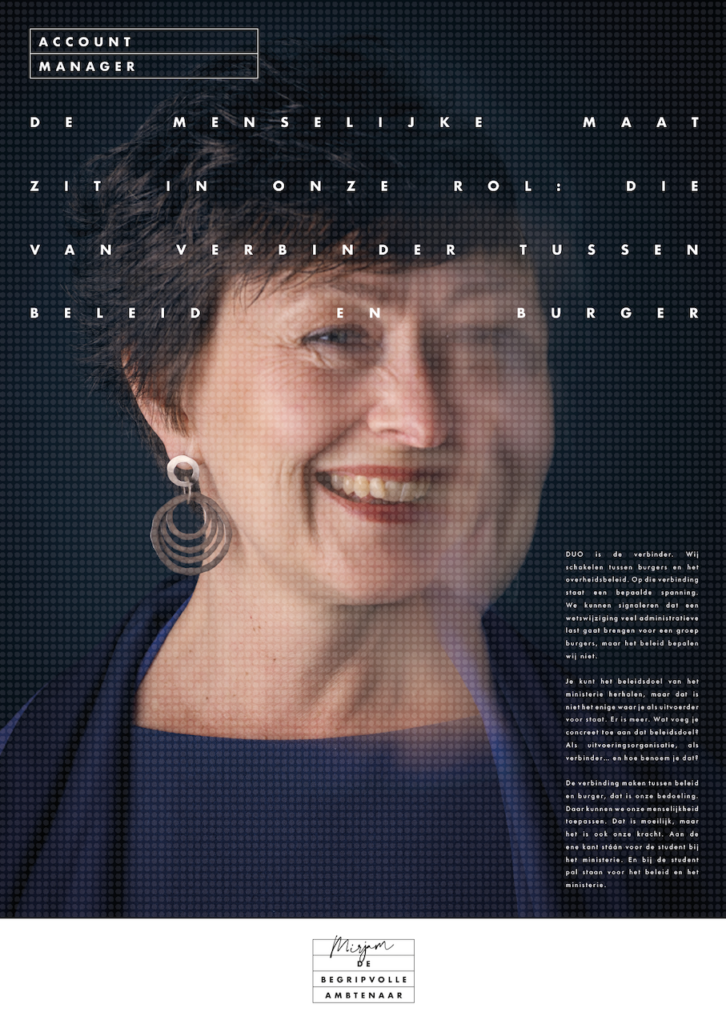Are government organizations such as the Executive Agency of Education an executor or a service provider? In this blog, I argue that we are both. And that we must learn to connect those two roles.
Last week the directorate at the Executive Agency of Education (DUO) where I work, for those in the know the Directorate of Education Followers, organized an event for employees to explore these kinds of questions. It was a super fun program and I got to talk about my research. In this blog, I share the short speech I gave during the morning program. And of course I was on a stage during this speech so you have to imagine while reading that I was also walking left and right across that stage during the speech.
Imagine a line.
We start here on the left side. This is the side of the collective. On the far right, there on the other side, is the individual.
What the collective finds valuable is not always the same as what an individual finds valuable. There is tension between them.
The side of the collective
Here on the left is where the conversation among politicians takes place. Political parties, together with the cabinet, legislate how we envision society. We just voted again, then we all had a say in how we are represented as a collective. Here it is conceived that we want to keep education accessible. But that it should also not be too expensive. At the time, the majority of the House of Representatives thought the loan system for student finance was a good idea. And last year, the majority of the House of Representatives felt that the basic scholarship should be brought back after all.
Those adjustments are translated into laws and into policies, by ministries. For example, at our ministry, of Education. And those laws and those policies must then be brought to the citizens.
We do that. DUO.
If you look at it that way, it is simple to say: we execute laws. We are an executor.
The side of the individual
Let’s go to that other side. The right side. This is the side of the individual. For example, a student. Who comes from a particular home, with parents, brothers and sisters. Has a certain background, culture, atmosphere at home, at school, a certain upbringing. She chooses a study. Art Academy in Utrecht, or sports at Alphacollege, here in Groningen. Perhaps she is studying law in Leiden.
In any case, what we know for almost certain is that she is applying for student finance. On duo.nl, logging in with DigiD, she wants the supplementary grant as well. After a year also the move-out scholarship, because she is moving out of the house.
We actually think of these types of students as citizen service numbers. They go smoothly through our systems. They arrange their own student finance, their loan, change their travel entitlement. We rarely speak to them, maybe if they call once. But they only do that when the shit hits the fan. And sometimes not even then.
I have been your colleague for 10 years. In recent years, I worked as a user researcher, investigating how students perceive us. A few years ago, I made a photo series of colleagues. I explored how we make our choices and how to be a compasstionate civil servant in the process. Now for a year I have been doing scientific research together with Delft University of Technology on how to make government services that are good for (the) people.
The value of student finance
Scientific research says about organizations like DUO that we are a service organization. A service provider.
Student finance is a service. Something that allows a student to create value. What is that value anyway? I would say to develop yourself as a person. Leaving home. Travel. Discovering life and discovering your place in it. Education is super important in this. That’s the goal. And that is our mission: to enable this development.
But scientific research also says that such a service organization must then organize itself from the outside in. So all the way around it should be: focused on the user, on the student on that right side. Continually listening and asking: how valuable does the student find our services? What can we improve?
The organization must then be set up with clear accountability over these experiences. Customer experiences then are not a catch-all or nice-to-haves. No golden taps but they are the starting point. Actually even before policy, and even before ICT changes. Indeed, those policies and ICT changes stem from increasing “customer value.
Government organizations have two outsides
But you can’t quite compare government to an average service organization. Because we have that flow from the left too, remember. That is also an outside. And that outside flows very strongly in our organization. That’s how we’re actually set up now, focused on that left outside to execute legislation. And rightly so, because the collective is also the citizen.

You probably recognize those flows. We are all in the middle of it. You might be a little closer to the collective stream. Or you might, on the contrary, experience more that individual side. It depends on where you are in the organization.
But the tension between that collective, what the law requires, and the individual, how it works out for that one student… We all feel that tension.
That is the big task for the coming time.
How can we translate what the collective finds valuable, in our democracy, into individual experiences that students also find valuable?
How should we deal with that tension? It poses difficult questions:
- What does this mean for how we offer the student finance? Should applying for student loans from DUO be easy or difficult? Super accessible, because there should be no barriers to arranging anything with the government, or difficult, because the loan results in student debt and thus an unlucky generation?
- How are we supposed to check if someone is misusing the student finance? For example, with the move-out scholarship? We verify on misuse in the interest of the collective. But can this verifying process also be a valuable experience for the individual, or are we really just harming them with the way we do it?
- How should we measure for customer satisfaction? For that, is wait time at the customer contact center really the most important KPI or should we have more qualitative measurements?
- Do we actually have a really good overview of the entire student experience? And does that flow get enough space in our organzation at all?
- And if you see something as a staff member that is not going well with a student, or a group of students, can you go against the flow?
- Do you dare?
Needed: Compassionate civil servants
In my photo series, I interviewed colleagues about how they are as a compassionate civil servant. And also, why sometimes they can’t be one. You can view the photos and stories at debegripvolleambtenaar.nl.
I want to highlight this one from Mirjam. She was an account manager when I photographed her. She’s actually pretty close to that collective side in her work.

Mirjam says, “DUO needs to be a connector.” At the ministry, at the collective side, stand for the student. As a kind of ambassador. This is possible only if that flow of the individual flows strongly in the organization.
“And at the student standing firm for policy.” So showing that collective flow here on the right.
Then you might think, pff, that will be chaos. We just have to embrace that chaos. And helping each other with that.
For that, we need to learn new things.
It starts with seeing both streams as equal. And to have our role in focus. Executor and also service provider. And especially connector of those two roles.
Want to know more?
On this blog, I think out loud how we can make government services that are good for people. I am researching this together with Delft University of Technology and public service organizations such as DUO.
- Student finance is a service, and its value is in the classroom. In this blog, I explain what this means for a different way of working in government.
- That government is not a typical service organization, but has two exteriors, I explain in the blog Trusting the process is not enough.
- If you want to follow my research, subscribe to my newsletter.
